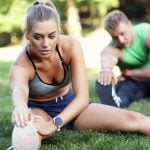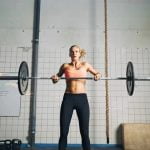In the quest for a well-rounded fitness routine, incorporating full-body workouts is crucial to achieving overall health and strength. Engaging in fitness exercises for the whole body ensures that each muscle group is targeted, leading to balanced physical development and improved functional movements. These exercises go beyond isolated muscle training, promoting coordination, stability, and cardiovascular endurance.
When it comes to full-body fitness exercises, the benefits extend far beyond just muscular strength. These workouts enhance flexibility, core stability, and overall body coordination. Additionally, they help in burning calories efficiently and can be a time-saving option for those with busy schedules. By engaging multiple muscle groups simultaneously, full-body exercises provide a comprehensive workout experience that yields optimal results.
Whether you are a beginner looking to kickstart your fitness journey or an experienced gym-goer wanting to amp up your routine, there are a variety of full-body exercises to choose from. From classic compound movements like squats and deadlifts to dynamic plyometric exercises and bodyweight circuits, there is something for everyone. Incorporating these diverse exercises into your workout regimen can lead to improved strength gains, enhanced endurance, and overall physical well-being.
Benefits of Full-Body Fitness Exercises
Full-body fitness exercises provide a wide range of benefits for individuals looking to improve their overall health and fitness levels. By engaging multiple muscle groups in a single workout session, these exercises help increase strength, improve endurance, and boost cardiovascular fitness. Additionally, full-body workouts are efficient and time-saving, making them ideal for those with busy schedules.
One of the key benefits of incorporating full-body fitness exercises into your routine is the ability to burn more calories in a shorter amount of time. Since these workouts target multiple muscle groups simultaneously, they can help elevate your heart rate and increase calorie expenditure. This makes full-body exercises an effective option for individuals looking to lose weight or maintain a healthy body composition.
When it comes to designing a full-body workout routine, there are several key exercises that can be particularly beneficial for improving strength and endurance across all muscle groups. Here are some top full-body exercises to consider including in your workouts:
- Squats
- Deadlifts
- Push-ups
- Pull-ups/chin-ups
- Burpees
Including these exercises in your workout routine can help you build functional strength, improve overall muscle tone, and enhance your physical performance. Whether you’re a beginner or a seasoned athlete, integrating full-body fitness exercises into your regimen can have a significant impact on your fitness journey.
Top 5 Full-Body Exercises for Strength and Endurance
When it comes to achieving overall fitness, incorporating full-body exercises into your workout routine is essential. These exercises target multiple muscle groups simultaneously, helping you build strength and endurance efficiently. Whether you are a beginner or an experienced fitness enthusiast, including these top 5 full-body exercises can take your workout to the next level.
1. Squats: Squats are a fantastic full-body exercise that targets your quadriceps, hamstrings, glutes, and core muscles. They help improve lower body strength and also engage your core for stability. To perform a squat correctly, stand with your feet hip-width apart, lower down as if sitting back into a chair, keeping your chest up and back straight, then push through your heels to return to standing position.
2. Push-ups: Push-ups are not only great for building upper body strength but also engage your core and lower body muscles for stability. They work your chest, shoulders, triceps, and abdominals all in one movement. Begin in a plank position with hands slightly wider than shoulder-width apart, lower yourself down by bending at the elbows until your chest nearly touches the ground, then push back up to the starting position.
3. Deadlifts: Deadlifts are a powerful full-body exercise that primarily targets the posterior chain – the muscles along the back of your body including hamstrings, glutes, and lower back. They also engage your core and upper body for stability as you lift the weight off the floor while maintaining proper form.
| Exercise | Muscle Groups Targeted |
|---|---|
| Squats | Quadriceps, Hamstrings, Glutes and Core Muscles |
| Push-ups | Chest, Shoulders Triceps and Abdominals |
| Deadlifts | Hamstrings Glutes Lower Back Core Muscles Upper Body for Stability |
Including these top full-body exercises in your workout routine will not only help you build strength and endurance but also improve overall functional fitness levels. Remember to focus on proper form and technique when performing these exercises to maximize their benefits and prevent injuries. Incorporating variety into your routine with different full-body movements can keep things interesting and challenge your body in new ways each time you work out.
Equipment-Free Full-Body Workouts for Home
When it comes to fitting in a full-body workout without access to the gym or equipment, there are still plenty of effective exercises that can target all major muscle groups. These equipment-free workouts can be done in the comfort of your own home, making it convenient and accessible for anyone looking to improve their overall fitness. From bodyweight exercises to using household items as makeshift weights, there are numerous options available.
Bodyweight Exercises
Bodyweight exercises are great for targeting multiple muscle groups at once without the need for any equipment. Moves like squats, lunges, push-ups, and planks engage various muscles in the body, providing a comprehensive workout. Incorporating a combination of these exercises into your routine can help build strength, endurance, and flexibility.
Household Items as Weights
If you’re looking to add resistance to your workout but don’t have access to traditional weights, get creative with household items. Items like water bottles, backpacks filled with books or canned goods, or even bags of rice can serve as makeshift weights for exercises like bicep curls, shoulder presses, and overhead tricep extensions. Using these items can add an extra challenge to your workouts without needing expensive equipment.
Circuit Training
Circuit training involves performing a series of different exercises back-to-back with minimal rest in between. You can create your circuit using a combination of bodyweight exercises and utilizing household items as weights.
This type of workout not only targets multiple muscle groups but also keeps your heart rate up for cardiovascular benefits. Creating a circuit workout that includes exercises like jumping jacks, mountain climbers, squats, and plank variations can provide a full-body workout right from your living room.
Incorporating Full-Body Exercises Into Your Workout Routine
When it comes to achieving overall fitness, incorporating full-body exercises into your workout routine is essential. These exercises engage multiple muscle groups at once, making them efficient for those looking to improve their strength, endurance, and overall physique. Whether you are a beginner or an experienced athlete, including full-body workouts in your regimen can bring numerous benefits to your fitness journey.
One of the key advantages of full-body exercises is that they promote functional movements that mimic real-life activities. This can help improve your balance, coordination, and flexibility while also enhancing your muscle strength. By engaging different muscle groups simultaneously, these workouts are time-saving and efficient, allowing you to get a full-body workout in a shorter amount of time compared to isolated exercises.
To get started with full-body exercises for the whole body, consider incorporating movements like squats, push-ups, lunges, deadlifts, and burpees into your routine. These exercises target major muscle groups such as the legs, core, chest, back, and arms, providing a comprehensive workout for your entire body. Additionally, using equipment like dumbbells or resistance bands can add variety and intensity to your full-body workouts for better results.
| Benefits of Full-Body Exercises | Key Advantages |
|---|---|
| Promote functional movements | Improve balance, coordination |
| Engage multiple muscle groups | Efficient and time-saving |
Common Mistakes to Avoid When Doing Full-Body Exercises
When engaging in full-body exercises, it is important to be mindful of common mistakes that can hinder your progress and potentially lead to injury. By being aware of these pitfalls, you can maximize the effectiveness of your workouts and achieve better results. Here are some key errors to avoid when performing fitness exercises for the whole body:
- Improper Form: One of the most common mistakes people make when doing full-body exercises is using incorrect form. This not only reduces the effectiveness of the exercise but also increases the risk of injury. Make sure to maintain proper posture and technique throughout each movement to target the right muscles and prevent strain.
- Overtraining: Another mistake to avoid is overtraining, especially when incorporating full-body workouts into your routine. It is important to give your muscles time to rest and recover in between sessions to prevent burnout and allow for proper muscle growth. Listen to your body’s signals and adjust your training schedule accordingly.
- Ignoring Warm-Up and Cool Down: Failing to warm up before a full-body workout or skipping a cool-down session after can also be detrimental. A proper warm-up helps prepare your muscles for exercise by increasing blood flow and flexibility, while a cool down helps reduce muscle soreness and prevents injury. Incorporate dynamic stretches and mobility exercises into your routine for an effective warm-up and cool down.
By being mindful of these common mistakes and taking steps to correct them, you can enhance the benefits of full-body exercises and improve your overall fitness level. Remember to prioritize proper form, avoid overtraining, and always include warm-up and cool down sessions in your workout routine. With dedication and consistency, you can make significant progress towards achieving your fitness goals through whole-body exercises.
Full-Body Workout Plans for Beginners, Intermediate, and Advanced Levels
When it comes to incorporating fitness exercises for the whole body into your workout routine, it’s crucial to consider your fitness level. Whether you are a beginner, intermediate, or advanced gym-goer, there are full-body workout plans tailored to suit your needs and goals.
Beginners
For beginners, starting with basic full-body exercises is key to building a strong foundation. Some recommended exercises include bodyweight squats, push-ups, lunges, and planks. These exercises target multiple muscle groups simultaneously, helping beginners develop overall strength and endurance.
Intermediate
As you progress to the intermediate level, incorporating more challenging movements can help take your fitness to the next level. Exercises like deadlifts, shoulder presses, pull-ups, and burpees can provide a greater challenge while still targeting the entire body. It’s essential for intermediate-level individuals to focus on form and technique to prevent injury and maximize results.
Advanced
Advanced gym-goers can benefit from complex movements that engage multiple muscle groups in one exercise. Incorporating exercises such as kettlebell swings, barbell squats, box jumps, and Turkish get-ups can push your limits and further enhance strength and endurance. It’s crucial for advanced individuals to continually challenge themselves with progressive overload to keep seeing improvements in their fitness levels.
The Importance of Rest and Recovery in Full-Body Training
Rest and recovery are essential components of any fitness regimen, especially when it comes to full-body training. Engaging in intense workouts that target multiple muscle groups can put a significant amount of stress on the body. Without adequate rest and recovery, the risk of overtraining and injury greatly increases. Rest allows the muscles to repair and rebuild, while recovery time is crucial for the body to adapt to the physical demands placed upon it during exercise.
Incorporating rest days into your full-body workout routine is key to ensuring long-term success and preventing burnout. When planning your exercise schedule, it’s important to schedule regular rest days where you focus on stretching or low-impact activities like yoga or walking. This downtime gives your body a chance to recover both physically and mentally, allowing you to come back stronger for your next workout.
Additionally, proper nutrition and hydration play a crucial role in effective rest and recovery. Maintaining a balanced diet rich in protein, carbohydrates, healthy fats, vitamins, and minerals can help support muscle repair and growth. Staying hydrated is also essential for flushing out toxins from the body and keeping muscles functioning optimally. By prioritizing rest, recovery, nutrition, and hydration in your full-body training regimen, you can maximize your results while reducing the risk of injury.
Conclusion
In conclusion, incorporating whole-body fitness exercises into your workout routine is essential for achieving overall fitness and health. Full-body workouts offer numerous benefits such as improving strength, endurance, flexibility, and balance. By engaging multiple muscle groups simultaneously, these exercises enable you to burn more calories and enhance your cardiovascular health.
It is important to include a variety of full-body exercises in your training regimen to ensure all muscle groups are targeted effectively. Some top full-body exercises include squats, deadlifts, push-ups, burpees, and plank variations. These exercises not only work on building strength but also help in improving functional movements that are vital for everyday activities.
Remember to listen to your body and take rest days when needed to allow for proper recovery. Consistency is key when it comes to whole-body workouts, so make sure to stay committed and gradually increase the intensity of your workouts as you progress.
With dedication and perseverance, you can achieve optimal fitness levels by incorporating full-body exercises into your regular routine. Start today and see the amazing results that come from focusing on fitness exercises for the whole body.
Frequently Asked Questions
Is There an Exercise That Works the Entire Body?
Yes, one exercise that works the entire body is compound movements like squats, deadlifts, and burpees. These exercises engage multiple muscle groups simultaneously, providing a comprehensive workout for the body.
What Is the Best Overall Workout?
The best overall workout is one that combines cardio, strength training, and flexibility exercises. This well-rounded approach ensures that all aspects of fitness are addressed, leading to improved endurance, strength, and mobility.
How Can I Make My Whole Body Fit?
To make your whole body fit, it is important to incorporate a variety of exercises targeting different muscle groups. Focus on cardio for endurance, strength training for muscle development, and flexibility exercises for mobility. Consistency and proper nutrition are also key factors in achieving overall fitness goals.

Passionate about providing useful information to anyone with an interest in the field of Personal Training, I strive to pass on to our readers quality information and to answer any questions about Personal Trainers, the work they do and how to become one.





